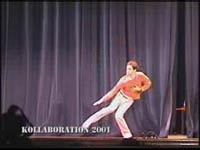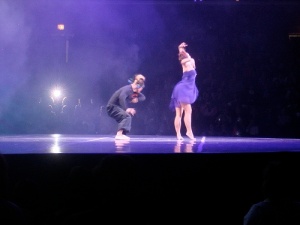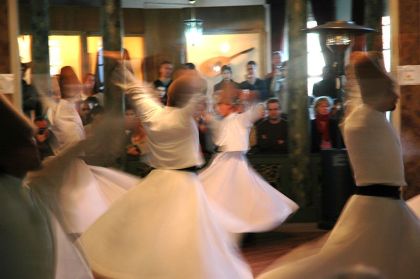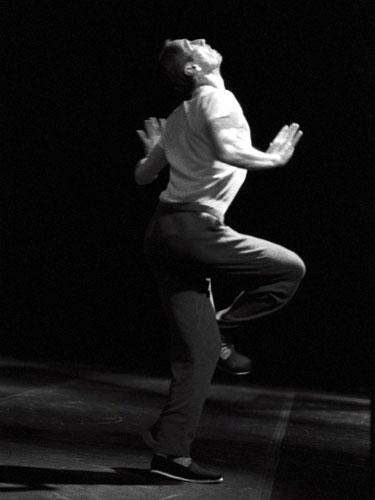Click on Dali’s painting to link to article. I’d like to read your comments about how these ideas relate to your work.
Filed under: Article, Video | Tags: elisabeth streb, falling, rennie harris, shen wei, style

HAS MODERN DANCE LOST ITS IDEALISM?
By ANNA KISSELGOFF
June 2, 1985
”I aim to speak the language of humanity, not the dialect of a folk.” The founding mothers of modern dance in America were prone to making such pronouncements and this statement, typically, came from the mother of them all, Isadora Duncan. Just as typically and in the same interview with The San Francisco Examiner in 1917, Isadora felt compelled to declare where her ”center of inspiration” lay. As the reporter indicated, she placed her hand on her breast and then on her brow. For Isadora, the source of movement was in the solar plexus. Later, in the 1930’s, the phrase ”fall and recovery” would be identified with the movement principles of Doris Humphrey just as ”contraction and release” would be identified with Martha Graham.
(click photos to watch video)
Here are a few more wonderful examples of falling with style.
The first one is from a great friend and artist Elizabeth Streb. Now, the “don’t try this at home” warning really applies here!
If you want to know more about Elizabeth’s work visit her web site:http://www.streb.org/
Next is Shen Wei. You may recognize some of his work from the Olympic’s opening ceremony. Shen Wei did the choreography for the calligraphy section (among others).
Shen Wei can be found at: www.shenweidancearts.org/
The last example is from Rennie Harris. Rennie is a fantastic hip hop choreographer from Philadelphia.
Check out his web site: http://www.rhpm.org/
Filed under: Uncategorized | Tags: Bernal, David, Elsewhere, liquid dance, popping
David “Elsewhere” Bernal (born August 2, 1979) is an illusionary dancer from Santa Ana, California. He became known through a viral video clip (Often titled Kolla2001) of himself dancing to Kraftwerk‘s song Expo 2000[1] recorded at the Korean-American talent show Kollaboration in 2001.
The clip showcased Bernal’s characteristic take on the contemporary dance styles of popping and abstract waving. Performances of these dances were rare at the time, and the clip became very popular when it circulated on the internet — so popular that in November 2006 the viral marketing company, The Viral Factory, collated page-impression figures from websites such as YouTube and Google Videos. They determined that, as of November 2006, this video had been viewed over 200 million times, making it the 8th most viewed video.Click here to read more about David
Filed under: Uncategorized
So You Think You Can Dance is an American dance reality show and competition that is broadcast on the Fox Network in the U.S. and Japan, on CTV and MuchMusic in Canada, on Living in United Kingdom and Ireland, on Network Ten in Australia, on AXN in India, on MBC 4 in the Middle East, on TVN in Poland, on MNET Series in South Africa and on KTN in Kenya.
o You Think You Can Dance holds auditions in major cities across the U.S., looking for the top dancers in each city. All types of dance backgrounds are encouraged to audition. Salsa, ballroom, hip hop, street dancing, contemporary, jazz, ballet and many other types of dancers can be seen auditioning for a chance to win the grand prize—which, in the past, has included a new Hybrid SUV, $100,000 in cash, and a dancing role in Celine Dion‘s Las Vegas show—of US$250,000 and the title of “America’s favorite dancer.” In its four seasons, the winners have been Nick Lazzarini, Benji Schwimmer, Sabra Johnson and Joshua Allen
Click to watch Jamie and Hok!
Filed under: Uncategorized
The Mevlevi, or “The Whirling Dervishes”, believe in performing their dhikr in the form of a “dance” and music ceremony called the sema.
The Sema represents a mystical journey of man’s spiritual ascent through mind and love to “Perfect.” Turning towards the truth, the follower grows through love, deserts his ego, finds the truth and arrives at the “Perfect.” He then returns from this spiritual journey as a man who has reached maturity and a greater perfection, so as to love and to be of service to the whole of creation.
The sema was practiced in the semahane (ritual hall) according to a precisely prescribed symbolic ritual with the dervished whirling in a circle around their sheikh, who is the only one circling around his axis. The dervishes wear a white gown (symbol of death), a wide black cloak (hirka) (symbol of the grave) and a high brown cap (kûlah), symbol of the tombstone. (read more)
Filed under: Uncategorized
When an apple fell on his head, Newton was inspired to describe the three laws of motion, that carry his name. … In his attempt to be objective, Newton overlooked the question of how it feels to be the apple. When we put our bodymass in motion, we raise above the law of gravity and go towards the swinging, circulating attraction of the centrifugal force. Dancers ride upon, and play with these forces. – Steve Paxton (1987)
Filed under: Uncategorized
Here’s a video clip (click photo) of the magnificent Fred Astaire in “You’re All The World To Me” from the film Royal Wedding. In one of his best-known solos, Astaire dances on the walls and ceilings of his room. The idea occurred to Astaire years before, and was first mentioned by him in the MGM publicity publication Lion’s Roar in 1945. The number was filmed by mounting the camera and operator in a cage which rotated with the room. The same technique would later be used to simulate a zero gravity environment in 2001: A Space Odyssey. (more)
Filed under: Uncategorized
I feel lucky to have had the opportunity to be around some of the world’s best turners, both in the schools I attended and the companies I worked for as an adult. Not being a natural turner myself, I spent a good portion of my career intently watching these dancers and breaking down and then applying what they do to my own body. After many years of practice, I came to turn very easily and confidently.
Turning is the confluence of lots of different things in the body working in tandem together. Below is a list of things that I have either worked on myself or noticed in other dancers.
Body
Turning is applied power, being two loose or two tight in your body or coordination is not the goal, it is finding the right mix. Two things that I noticed very clearly about many good male turners is that they are built like inverted cheese wedges. They tended to have very large backs, relative to their hips. I think this is because, like a tightrope walker holds their arms out when walking a wire, I think your back, arms and lat muscles play an extremely important role in achieving balance. These muscles, for dancers who really work hard at turning, become more developed because they are used so aggressively.
Having more strength in your upper body will definitely help your turns. That said, it is applied power, so building the muscle up has to be in tandem with stretching your back so you do not become too tense.
The other crucial thing I noticed is not having tension in your psoas tendon, which runs in the front of your hip. When this tendon is tight, it flares the hips (tilted towards the floor), which in turn disengages your stomach and inner thighs slightly. Your hip placement should resemble how you feel when you lying on your back on the floor and are relaxed. The application of turnout tends to cause people to flare their placement, which in turns makes turning and accessing your center difficult.
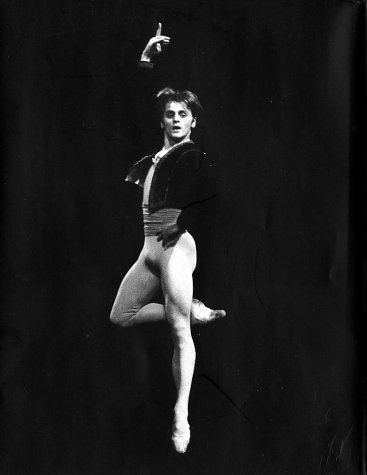
(click here to see Baryshnikov in “Carmen”)
Arms
If you just causally spin around in a circle with your arms relaxed, and with centriphical force allow your arms (as you spin around multiple times) to gradually come to first position – you will nice that there is nothing arbitrary about where arm arms are placed relative to how our individual rotator cuffs (shoulders) are aligned. In the same way that you achieve stability in ballet by rotating your arms outwards till they cannot rotate anymore, our shoulders work the same way, except it is the opposite rotation (towards the ground). Finding the end point in your shoulder rotation gives you a tremendous platform to then feel your back as you turn.
Most turners also turn crooked. You will notice that the shoulder on the passé side rarely comes completely in line with the hip – which the hands, if you stop turning and keep your arms up, tend to not be centered with the body. Getting your shoulder back the couple inches it is dragging behind the hip can give you a significant increase in power (to then achieve more turns). It is a matter of locking that arm to your back so it really pulls you around through the turn.
Legs
Standing in relevé fifth position, draw your leg up to passé. Ideally your hips should not shift, and this should feel different than just drawing your leg up and extinguishing the oppositional forces created in working the leg up as the hip pushes down. As the passé comes up, the opposite side of the back engages to create strength across your center.
Many teachers also talk about pulling up. My teacher said unless you can fly, standing in balance is about pushing into the floor and feeling deeply rooted. This change of perspective helped me find consistency in my turns, it took the “hopeful” feeling out of my turns. Also if you can not let it be a huge emotional shift going from flat to relevé, that also helps. Try thinking about it, that you are only lifting your heal four inches, and when thought about like that, it does not seem drastic at all.

(click here to watch Michael Revie turn)
Turn the Opposite Direction
My teacher used to say turn left when we were turning right. Ballet turns are a reflection of both legs turning out evenly. In addition to spinning to the right, you generate forces that spin the other direction, which is why great turners look beautifully rhythmic and not spinning. This thought of the turn spinning the other way, engages the standing leg and side, so that you are truly reflecting the beautiful endpoints of your physicality when turned out. My teacher used to say you never turn around the corner, that the turns just exist front always.
An example of this was my good friend Jose, who could do 10-12 pirouettes consistently. He could face you, close his eyes, do six pirouettes and end perfectly facing you. He could also do this trick completely drunk.
Concave Front
I noticed that great turners never fall back. It looked to me that they created a slight concave in the front of their bodies – a very slight curve from their forehead to their feet. They also generated energy spinning vertically through their arms. I think many people tend to fall back as a reflection of turning out to too par which causes the hips to splay forward, then the back counterbalances backwards to try and balance, but since the back and head are so heavy it tens to draw people back. Stand in your real turnout and you will be one step closer to not falling back. I used to also tell myself “fall forward”.
The Mind
If you think you can’t turn you can’t, if you think you can you can. Also, the mind is very hard sometimes to reprogram. Most dancers will always fall the exact same direction. This rings more of habit than of some sort of deficiency. Try and over emphasize what ever the opposite of your habit is to try and wrangle the habit out of you. Ex. If you fall towards you passé leg always, then try and really fall the opposite direction.
Finishing
My friend Jose told me one day that the secret to a good clean pirouette is always finishing cleanly. He said that if you always practice a good clean finish that that translates backwards and reciprocally cleans the actual turn up. Many of us have the habit, that if the turn is not “going well”, we give up and do some phony finish, pretending “something” went wrong. Forcing yourself to finish in a real position no matter how the turn goes, will make you turn better in short time. Also a pirouette isn’t complete until it finishes.
If you turn three turns it is in a four count – the forth count being the finish.
Fun
Beyond all this, if your turning gets to cerebral and heady, remember to have fun. If dancing doesn’t stir your spirit somehow, it makes it very hard to learn. Just have fun, and enjoy spinning in space. Whether you are an amazing turner or consider yourself “not a turner”, remember that relative to most of the world you can do something quite extraordinary.
For more information about Alex Ketley visit his web site at www.alexketley.com
Filed under: Uncategorized
We’ve created some new pages to help you get connected to the dance world. Joanna compiled a list of dance centers here in San Francisco, and also a list of some teachers who would be good to study with. You can see this new page on the left, under the calendar, titled “Dance Classes in San Francisco.”
We also put the Syllabus up on its own page, also over on the left, under the calendar, titled “Syllabus.”
Enjoy!





